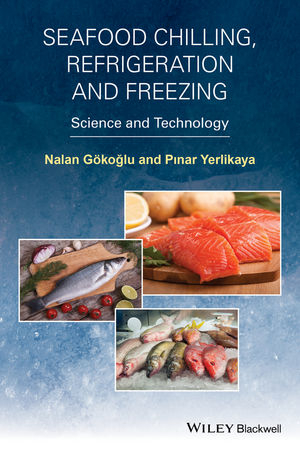
Seafood Chilling, Refrigeration and Freezing
Wiley-Blackwell (Verlag)
978-1-118-51218-0 (ISBN)
- Titel z.Zt. nicht lieferbar
- Versandkostenfrei innerhalb Deutschlands
- Auch auf Rechnung
- Verfügbarkeit in der Filiale vor Ort prüfen
- Artikel merken
Seafood Chilling, Refrigeration and Freezing presents the science behind the chilling, refrigerating and freezing of fish and seafood, describing the chemical, microbiological and physical changes which take place during preservation, and considering the new technologies which can be used, highlighting their benefits and their economic implications. The book takes account of the different requirements for different breeds of fish and seafood, and includes both traditional and novel technologies, providing both current and future perspectives. It will be required reading for food scientists, fish processors and retailers as well as fish specialists, researchers and process designers.
Nalan Gökoðlu is the Dean of the Fisheries Faculty at Akdeniz University in Turkey. She has worked as a researcher on fish processing, preservation and quality issues for almost 25 years, and also teaches in these subjects. Pinar Yerlýkaya is in the Fisheries Faculty at Akdeniz University, Turkey, where she works on fish processing and quality issues.
Preface ix
1 Introduction 1
1.1 Spoilage of seafood 1
1.2 Preservation of seafood 2
1.2.1 Chilling 3
1.2.2 Refrigeration 3
1.2.3 Freezing 3
2 Chemical composition of fish 5
2.1 Proteins 5
2.1.1 Sarcoplasmic proteins 6
2.1.2 Myofibrillar proteins 7
2.1.3 Stroma proteins 8
2.1.4 Non]protein nitrogen compounds 9
2.1.4.1 Free amino acids 9
2.1.4.2 Peptides 10
2.1.4.3 Nucleotides 10
2.1.4.4 Guanidine compounds 12
2.1.4.5 Trimethylamine oxide (TMAO) 12
2.1.4.6 Urea 13
2.1.4.7 Betaines 13
2.2 Lipids 13
2.2.1 Saturated fatty acids 15
2.2.2 Mono]unsaturated fatty acids 16
2.2.3 Poly]unsaturated fatty acids 16
2.3 Carbohydrates 18
2.4 Minerals 19
2.4.1 Macroelements 20
2.4.2 Microelements 21
2.5 Vitamins 22
2.5.1 Fat]soluble vitamins 23
2.5.2 Water]soluble vitamins 24
2.6 Conclusion 25
References 32
3 Quality changes and spoilage of fish 38
3.1 Introduction 38
3.2 Factors affecting quality of fish 39
3.2.1 Species 39
3.2.2 Size 40
3.2.3 Distance to port 41
3.2.4 Diet of fish 41
3.2.5 Fishing grounds and methods 41
3.2.6 Sex 42
3.3 Post]mortem changes in fish muscle 43
3.3.1 Rigor mortis 44
3.3.2 Chemical changes 45
3.3.3 Microbiological changes 48
3.3.4 Enzymatic changes 50
3.3.5 Sensory changes 54
References 55
4 Chilling 58
4.1 Fundamentals of chilling 58
4.2 Chilling of fish 60
4.2.1 Chilling methods of fish: traditional and advanced 60
4.2.1.1 Chilling with ice 60
4.2.1.2 Chilling with water–ice mix/slurry ice 81
4.2.1.3 Use of chilled /refrigerated sea water 85
4.2.1.4 Chilling with dry]ice 89
4.2.1.5 Super]chilling 92
4.3 Chilling on board 96
4.3.1 Icing on board 97
4.3.2 Bulk stowage 100
4.3.3 Shelved stowage 102
4.3.4 Boxed stowage 102
4.3.5 Quantity of ice needed on board 103
4.3.6 Use of refrigerated seawater 103
4.3.7 Use of chilled seawater 104
4.4 Combination of chilling with traditional and advanced preserving technologies 104
References 107
5 Quality changes of fish during chilling 113
5.1 Introduction 113
5.2 Chemical changes 115
5.3 Microbiological changes 119
5.4 Enzymatic changes 119
5.5 Physical changes 122
5.6 Sensory changes 123
References 123
6 Refrigeration 128
6.1 Introduction 128
6.2 Fundamentals of refrigeration 129
6.3 Refrigeration systems 133
6.3.1 Vapour]compression system 135
6.3.2 Air]cycle system 144
6.3.3 Absorption system 145
6.3.4 Thermoelectric system 145
6.3.5 Evaporative cooler 146
6.4 Refrigerants 146
6.4.1 Classification of refrigerants 147
6.4.1.1 Halocarbons 148
6.4.1.2 Hydrocarbons (HCs) 149
6.4.1.3 Inorganic compounds 149
6.4.1.4 Refrigerant blends 150
6.4.2 Ozone depletion potential 151
6.4.3 Global warming potential 151
6.4.4 Safety of refrigerants 152
6.5 Refrigeration of fish 152
6.6 Refrigeration on board 153
6.6.1 Refrigeration capacity 155
6.7 Combination of refrigeration with traditional and advanced preserving technologies 157
References 160
7 Freezing technology 163
7.1 Principles of freezing 163
7.1.1 Water and ice 164
7.1.2 Nucleation in pure water 165
7.1.3 Freezing point depression 165
7.1.4 Crystallization and crystal growth 166
7.1.5 Recrystallization 167
7.1.6 Freezing time 168
7.1.7 Freezing velocity 170
7.2 Biological aspects of freezing 170
7.2.1 Cryopreservation of cells and other biomaterials 170
7.2.2 Biological ice nucleation 172
7.2.3 Antifreeze proteins 173
7.3 Freezing methods 174
7.3.1 Air blast freezing 175
7.3.2 Indirect contact freezing 177
7.3.3 Immersion freezing 178
7.3.4 Cryogenic freezing 179
References 181
8 Freezing and frozen storage of fish 186
8.1 Effects of freezing and frozen storage on fish quality 186
8.1.1 Chemical and nutritional changes 187
8.1.2 Microbiological changes 191
8.1.3 Physical changes 193
8.1.4 Sensory changes 195
8.2 Shelf life of frozen fish 196
8.3 Freezing of fish on board 198
8.4 Transportation of frozen fish 200
8.5 Combination of freezing with traditional and advanced preserving technologies 201
References 203
9 Thawing of fish 208
9.1 Quality changes of fish during thawing 208
9.2 Thawing methods of frozen fish 213
9.2.1 Thawing with air 213
9.2.2 Thawing with water 214
9.2.3 Thawing under vacuum 215
9.2.4 Thawing with electrical resistance 215
9.2.5 Dielectric thawing 217
9.2.6 Microwave thawing 217
9.2.7 Thawing with hydrostatic high pressure 219
9.2.8 Ultrasound]assisted thawing 221
9.2.9 Summary 223
9.3 Recommendation for GMP in seafood thawing 223
References 224
Index 228
| Verlagsort | Hoboken |
|---|---|
| Sprache | englisch |
| Maße | 158 x 236 mm |
| Gewicht | 454 g |
| Themenwelt | Technik ► Lebensmitteltechnologie |
| Weitere Fachgebiete ► Land- / Forstwirtschaft / Fischerei | |
| ISBN-10 | 1-118-51218-9 / 1118512189 |
| ISBN-13 | 978-1-118-51218-0 / 9781118512180 |
| Zustand | Neuware |
| Haben Sie eine Frage zum Produkt? |
aus dem Bereich


